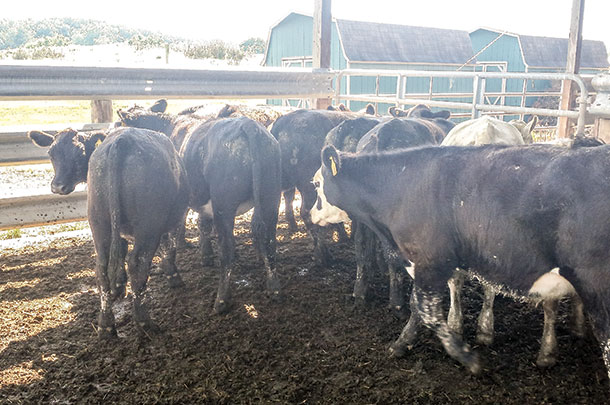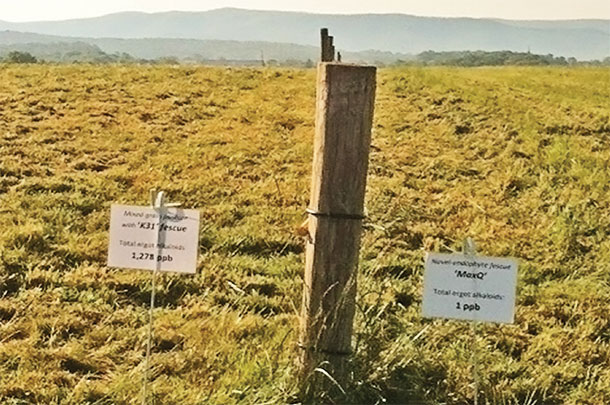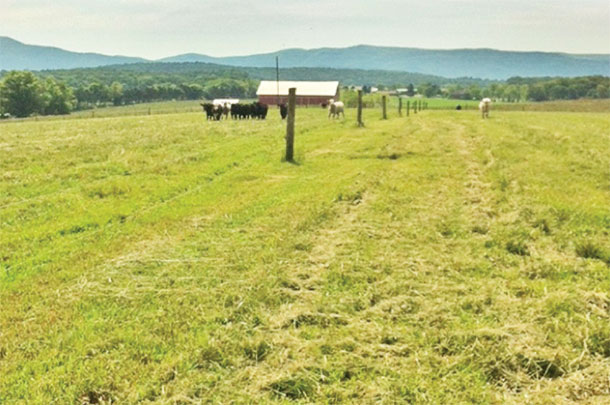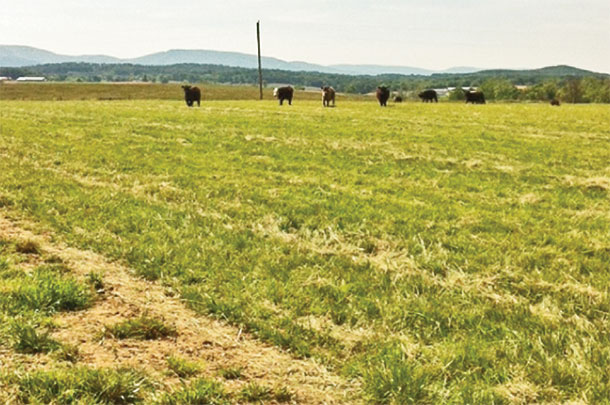The staff takes height, weight and blood pressure; for a complete health screen, blood and urine samples are taken for cholesterol, triglycerides, sugars, etc. From this information, doctors prescribe dietary and exercise regimens or even medications to combat any revealed problems.
However, this same producer will return to the ranch and continue to turn animals onto tall fescue pastures without knowing the nature or the amount of toxicity inherent there – which is much less like the doctor who designs a management program to combat the problem.
Fescue toxicosis and novel endophyte varieties
Tens of millions of acres of tall fescue were planted and used for erosion control, turf and pasture in the U.S., mainly with the Kentucky 31 variety. When pastured, however, animal health problems became evident (e.g., fescue toxicosis).
Researchers identified the causal agent within tall fescue as a “mutualist, symbiotic, endophytic fungus” (Neotyphodium coenophialum – or commonly, the endophyte, and the toxic version as E+). Surveys within fescue-belt states found nearly all pastures contained high levels of E+ fescue.
It is production of ergot alkaloids, with ergovaline in the highest percentage, by the endophyte living within the plant that results in toxicosis.
Ergots depress blood prolactin levels resulting in reproduction and milk production problems, especially in horses, but more commonly, causing blood vessel constriction leading to problems such as “fescue foot,” “rough hair coat” and “summer slump.” The cost to the livestock industry is conservatively estimated at a billion dollars per year.
The initial answer to the problem was to remove the fungus from the seed (fungus-free or E-) before planting. Unfortunately, E- fescue had poor stand persistence.
Therefore, endophyte-infected tall fescue presented the classic dilemma: animal health versus pasture persistence. This resulted in agronomic efforts to address the problem by mitigation of toxic pastures (inter-planting clovers, removing seedheads, pharmaceuticals, etc.) or development of persistent, non-toxic (novel) endophyte varieties and using them to replace toxic pastures.
After intensive “proof of concept” research, a novel endophyte strain was found that when re-infected into the Jesup variety, removed toxicosis and allowed the plant to remain persistent.

Jesup MaxQ became the first novel product successfully commercialized. Other products were subsequently developed, and the following novel endophyte tall fescue varieties are now commercially available (listed alphabetically): BarOptima Plus E34, Duramax Gold, Estancia with ArkShield, Jesup MaxQ, Martin2Protek and Texoma MaxQ II.
The main challenge is, as a group, these novel varieties are not planted. There were 28,000 acres of tall fescue “forage type” and “K-31 and other” seed production in Oregon during 2013-2014 (Oregon grass seed forecast).

At an average yield of 1,300 pounds of seed per acre, approximately 34 million pounds were produced in Oregon alone for the forage market, yet annual sales of all novel varieties are estimated, at best, at 500,000 pounds during that time.
Even E- varieties were probably sold at a similar level. So, for such a large seed market, why are products that double animal performance and increase animal health (with less persistence problems than E-) not being bought and used?
Since there are several, easily available management guides on effectively and economically replacing toxic tall fescue, the best answers are found in a survey conducted in 2005 by Craig Roberts with University of Missouri and John Andrae with Clemson University.
They reported the main problem was the time and monetary costs, but especially the temporary non-use of land required for the replacement process itself.
A new approach using a health care model
Therefore, the general rationale among producers is, “I do not think I have a problem, or if I do, it is probably minimal or can be mitigated, so why take a risk of replacing my pasture?” What is needed is a cultural change to approach fescue toxicosis as one would their own health care by asking the following question, “What are the toxic alkaloid levels in my pastures and, once known, what is my best approach – mitigation or replacement?”
First, sample pastures for toxic ergot alkaloids. Private and public labs will conduct analyses for a reasonable fee. The power of alkaloid sampling as a decision tool is seen in an initiative in the Shenandoah Valley of Virginia by agents Matt Booher and John Benner (see article in Progressive Forage Grower, February 1, 2016 issue What we've learned about tall fescue management).
Twenty-five pastures, representing about 10,000 animals, were tested in three counties with 65 percent of pastures 100 percent infected; 30 percent of pastures were 80 to 90 percent infected; the lowest infection rate (one pasture) was 50 percent infected.

The spring total ergot alkaloid levels were above 1,000 parts per billion (ppb) with some as high as 7,000 ppb. Conclusion: Toxicosis is detrimental and widespread in the region.
Second, from these analyses, design a management plan to combat toxic alkaloids and the resultant animal health problems. There is some debate on alkaloid threshold levels, but if ergovaline is between 150 and 500 ppb, then one needs to consider mitigation such as removing seedheads (when alkaloids are at their highest concentration) or inter-planting other species, especially legumes.
This approach would be analogous to a doctor recommending diet and exercise when your blood pressure or cholesterol levels are marginal.
If alkaloids are higher than 500 ppb, mitigation may not be enough. In a report from the Samuel Roberts Noble Foundation (Study reveals legume-fescue mixture economics), mitigation with white clover dramatically improved net return from a loss of $63 per acre for very toxic E+, to a gain of $22 per acre for E+ inter-planted with clover.
But the clover-mitigated E+ animals were evidently still in costly toxicosis, as seen by the dramatic increase in net return of an additional $100 per acre when MaxQ without clover was compared to the E+ and clover treatment.
When alkaloids are high, that from the above Virginia example is common. The Alliance for Grassland Renewal (Alliance for Grassland Renewal) recommends replacement of existing E+ fescue with novel fescue. This would be the medical equivalent of using prescription medications.
Convincing producers to replace toxic pastures
Producers are understandably fearful about removing a strong grass stand, even if only for six to eight months. They certainly have questions about handling animals during that time of less acreage. Overcoming these risks is producer-specific, and is best planned individually based on experience and production goals.

Extension specialists and seed companies can assist by establishing on-farm examples to demonstrate replacement strategies and outcomes. The medical analogy makes sense to most producers, but they also believe their neighbors and what they see.
One demo protocol is to replace half an E+ pasture with a novel variety. Animal behavior and production between the two areas are then compared.
When Pennington Seed and Virginia Tech near Weyers Cave, Virginia, established a similar demo in August 2015, a May 2016 field day showed extreme differences in alkaloid levels; animal behavior differences were also already evident.
Whether one uses mitigation or replacement, continue monitoring alkaloids. After all, there are still millions of acres of E+ contamination, and wouldn’t your doctor monitor your blood pressure and cholesterol, and adjust your medical plan accordingly, even if temporarily under control? ![]()
PHOTO 1: KY31 E+ cattle showing less hair coat shed and more body mud than cattle grazing
PHOTO 2: Replaced with novel endophyte variety (MaxQ) during July
PHOTO 3: An on-farm demonstration sponsored by Pennington Seed and Virginia Tech at Bud Shaver’s Lucky Charms Farm shows the value of alkaloid sampling and the replacement of one-half of a toxic tall fescue field with a novel endophyte variety.
PHOTO 4: The animals on the toxic side (left) are bunched up, lethargic and not grazing while animals on the right side of the fence are scattered throughout the field and grazing normally. Photos by Joe Bouton.
Joe Bouton is an emeritus professor with the Dept. Crop and Soil Sciences – University of Georgia. Joe is also with Bouton Consulting Group LLC. Email Joe Bouton.





